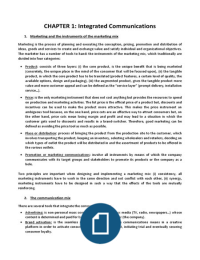CHAPTER 1: Integrated Communications
1. Marketing and the instruments of the marketing mix
Marketing is the process of planning and executing the conception, pricing, promotion and distribution of
ideas, goods and services to create and exchange value and satisfy individual and organizational objectives.
The marketer has a number of tools to hand: the instruments of the marketing mix, which traditionally are
divided into four categories:
• Product: consists of three layers: (i) the core product, is the unique benefit that is being marketed
(concretely, the unique place in the mind of the consumer that will be focused upon), (ii) the tangible
product, in which the core product has to be translated (product features, a certain level of quality, the
available options, design and packaging), (iii) the augmented product, gives the tangible product more
value and more customer appeal and can be defined as the “service layer” (prompt delivery, installation
service…).
• Price: is the only marketing instrument that does not cost anything but provides the resources to spend
on production and marketing activities. The list price is the official price of a product but, discounts and
incentives can be used to make the product more attractive. This makes the price instrument an
ambiguous tool because, on the one hand, price cuts are an effective way to attract consumers but, on
the other hand, price cuts mean losing margin and profit and may lead to a situation in which the
customer gets used to discounts and results in a brand-switcher. Therefore, good marketing can be
defined as avoiding the price tool as much as possible.
• Place or distribution: process of bringing the product from the production site to the customer, which
involves transporting the product, keeping an inventory, selecting wholesalers and retailers, deciding on
which types of outlet the product will be distributed in and the assortment of products to be offered in
the various outlets.
• Promotion or marketing communications: involve all instruments by means of which the company
communicates with its target groups and stakeholders to promote its products or the company as a
hole.
Two principles are important when designing and implementing a marketing mix: (i) consistency, all
marketing instruments have to work in the same direction and not conflict with each other, (ii) synergy,
marketing instruments have to be designed in such a way that the effects of the tools are mutually
reinforcing.
2. The communication mix
There are several tools that integrate the communication mix:
• Advertising: is non-personal mass communications using mass media (TV, radio, newspapers…) whose
content is determined and paid for by a clearly identified sender (the company).
• Brand activation: is the seamless integration of all available communications means in a creative
platform in order to activate consumers by stimulating interest, initiating trial and eventually securing
consumer loyalty.
1
, • Sales promotions: as part of brand activation, are sales-stimulating campaigns (price, coupons…).
• Sponsorship: the sponsor provides funds, goods, services or know-how and the sponsored organization
helps the sponsor with communication objectives (building brand awareness or reinforcing image).
• Public relations: all the communications a company instigates with its audiences or stakeholders (press
releases and conferences – not paid for by the company and written by journalists, which means that
negative publicity is also possible).
• Point-of-purchase communications: communications at the point of sale (displays, merchandising…).
• Exhibitions and trade fairs: very important for contacting prospects, users and purchases (B2B markets).
• Direct marketing communications: personal and direct ways to communicate with customers and
potential clients or prospects (personalized brochures, direct mailings, telemarketing actions…).
• E-communications: new ways to communicate interactively with different stakeholders.
Marketing communications try to influence the potential consumer by conveying a message, which could be
(i) transfer directly to certain known and individually addressed persons (personal communications), (ii)
directed to a number of receivers who cannot be identified using mass media to reach a broad audience
(mass communications).
Another way to categorize marketing communications instruments is to differentiate between: (i) image or
theme communications, where the advertiser tries to tell the target group something about the brand or
products and services offered with the goal of improving relations with target groups, increasing customer
satisfaction or reinforcing brand awareness and brand preference (above-the-line-communications – they
used to lead to a 15% commission fee on media space purchased), (ii) action communications (below-the-
line communications), try to influence the buying behavior of target groups and to persuade the consumer
to purchase the product with the goal to stimulate purchases.
3. Integration of marketing communications
Communications instruments that traditionally have been used independently of each other are combined in
such a way that a synergetic effect is reached and the resulting communications effort become seamless or
homogeneous. The major benefit of IMC is that it has added value (consistency and synergy) when
compared with traditional marketing communications.
CLASSIC COMMUNICATIONS INTEGRATED COMMUNICATIONS
Aimed at acquisition Aimed at retention, relationship management
Mass communications (monologue) Selective communications (dialogue)
Information is sent (sender’s initiative) (provision) Information is received (receiver’s initiative)(self-
service)
Transaction-oriented Relationship-oriented
Persuasive “hold-up” Provide information
Effective through repetition Effective through relevance
Salience of the brand Confidence in the brand
Attitude change Satisfaction
Hard sell (offensive) Soft sell (defensive)
IMC do not happen automatically. All the elements of the communications mix have to be carefully planned
in such a way that they form a consistent and coherent integrated communications plan. As a consequence,
2




